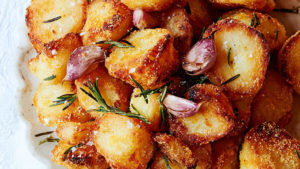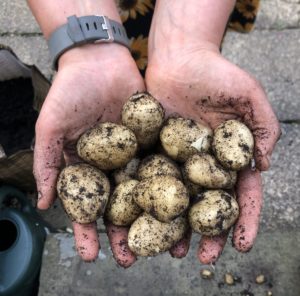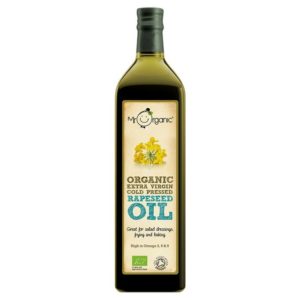It’s time to hang up your lab coats and don the festive jumpers! Christmas is just around the corner and for many of you, it will be a very different, smaller occasion this year. Whether it is now your responsibility to cook a big roast dinner, you’d like to try something new in the kitchen or you simply want to find out why roast potatoes are so great – this blog post will be for you!
This week our guest writer, festive foodie Scientist and 1st year WRDTP student, Emma White is ready to give you the low down on some of the science behind cooking those delicious crispy Roasties.

How to make the best roast potatoes for your Christmas dinner
At the end of a very tough year, the thought of gorging on golden and crispy roast potatoes on Christmas Day feels like a wonderful dream which we all deserve to realise. It is a known fact that making the perfect roast potatoes to accompany Christmas dinner is an art which can take years to master. But what would happen if, instead of an art, we begin to think of cooking as a science? Is it possible to break down each ingredient to its fundamental components and determine how to combine and cook them to bring out the best flavours and textures? This article will explore that idea, focusing on the science behind roasting potatoes.
—
The Potatoes:
The number of potato varieties you can find in the supermarket may seem overwhelming to the average person, however experts tend to sort them into two categories: “Mealy” and “Waxy”. “Waxy” potatoes have less starch and stronger cells, which gives them a firmer texture. Charlotte and Nicola varieties are examples of waxy potatoes, and are ideal for boiling, steaming and for adding to salads. “Mealy” potatoes have a higher starch content, and include varieties such as Maris Piper and Rooster. Potato cells which are more tightly packed with starch rupture more easily when cooked, which not only leads to a soft, fluffy texture, but also generates a coat that can be browned to form a crispy outer layer. According to “The Science of Cooking” by Dr Stuart Farrimond, the best variety of potato for roasting is Maris Piper, as it is the easiest to get soft and fluffy on the inside, whilst forming a tasty crust on the outside.
—
The Fat:
The use of fat in cooking is all about adding and enhancing flavours. Oils contain unsaturated omega-3 and -6 fats, while saturated animal fats such as lard can raise cholesterol, so this article will focus primarily on the use of liquid oils in roasting. However, both of these types of fats can enhance the flavour and texture of food by easily dissolving flavour molecules from herbs and spices while conducting heat to the surface of the food.
With a higher boiling point than water, oils allow food to be cooked at high temperatures. Immediately before reaching their boiling point, the molecules in the flavour-enhancing impurities of the oils are pulled apart and the structure of the oil disintegrates and darkens. This is called the “smoke point” of the oil and varies in temperature depending on the type of oils used, but in all cases makes the food taste bad. There is a very careful balance related to refinement of oils, as over-refined oils lack taste, but oil containing too many impurities will have a lower smoke point and burn easily. Rapeseed oil, with a smoke point of around 205oC, is thought to be the best for roasting as heating to temperatures of 180oC-200oC for a prolonged period of time will maximise the flavour without hitting the smoke point. If you were to use extra-virgin olive oil to roast your potatoes, the low smoke point of 160oC will mean that they taste foul, so being aware of the type of oil you are using is very important!
Note on cold-pressed vs normal rapeseed oil: in the process of making the oil, heating allows for the oil to be drawn out more easily, but this can cause fragrances to evaporate (hence making it less flavoursome) as well as shortening its shelf-life. If your oil is “cold-pressed”, this means that it has not been heated above 27oC during production, which makes the flavour better but the oil more expensive.
—
This year, I am going to roast Maris Piper potatoes, tossed in cold-pressed rapeseed oil, to accompany my dinner on the 25th. Will you follow the science of cooking, or will you treat it as an art?


